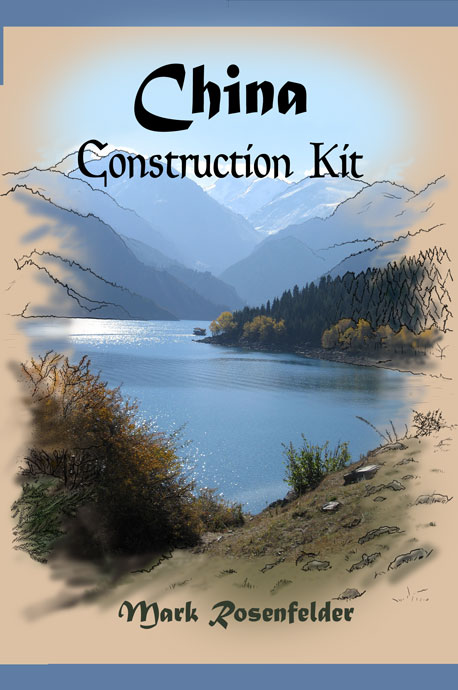

by Mark Rosenfelder
When aliens find us, what will they call the Earth? Terra? Nah, probably Dìqiú… that is, what our planet’s leading civilization calls us.
For two thousand years China has been the most populated region of the planet, and usually the richest and most technologically advanced as well. For the last few centuries the West gave it a run for its money, but on historical scales that’s looking more and more like a temporary blip.
And yet in the West, most of us learn little about China. With this book, you’ll know more about China than everyone around you.
Who is it for?
- Anyone who wants to know more about China and Chinese.
- Conworlders who’d like to create a China-like con-culture, or set an RPG campaign in a historical or legendary China.
- Conlangers who aim to create an isolating language or a non-alphabetic writing system.
- Writers who’d like to try a non-Western setting.
What’s covered?
- An overview which provides orientation (there’s a pun there, I’m sure of it) for what follows: pronunciations, the dynasties, climate regions, the north/south divide, provinces and cities, language families.
- A history from the Shāng dynasty through the death of Dèng.
- Overviews of the major belief systems— Confucianism, Dàoism, Buddhism, Máoism— as they come up.
- Chapters on cosmology and medicine, architecture, clothing, and technology.
- An overview of Chinese literature from the oracle bones onward.
- A chapter on conworlding: how to use all this information to create a fantasy culture that’s not the Standard Medieval European Kingdom, or an sf culture that’s not Fifties America in Space. Plus how to avoid a disparaging Orientalism.
- Grammatical sketches of both Mandarin and Old Chinese, plus a meaty overview of the writing system.
A history for language lovers
I expect most of my readers are interested in language, so this is one introductory book that doesn’t skimp on linguistic details. Chinese words are given tone (and key terms in characters); we’ll often consider the meaning of names, Chinese and otherwise; poems are cited in Chinese so that the meter and rhyme are not hidden.

Or if you want to give me slightly more royalties, order it here!
Did you know...?
Some random bits from China Construction Kit :- The Chinese were aware of the Roman Empire, which they called Dàqín— curiously, using the name of their own founding dynasty. However, they were more aware of Persia, Ānxī. The prototypical blue and white coloration of Míng-era porcelain was chosen because the Persians preferred those colors.
- Chinese alchemists were obsessed with longevity, and aspired to immortality. The author of the Dào Dé Jīng, Lǎozǐ, was retroactively turned into a semi-divine immortal. Their concoctions probably killed more than one emperor.
- In late imperial times, agricultural productivity in south China gave a seed-to-yield ratio of up to 51. Compare to the best figure for Europe before 1750, achieved in England and the Netherlands: 8.7.
- Tea was not widely drunk in China till the Sòng dynasty (i.e. after 960). In early days, tea was mixed with flour, salt, and ginger. It’s still mixed with yak butter in Tibet.
- The abacus is faster than pen and paper; I’ll show you how to do long division on one.
- Women had their own literature that men rarely read. One of the best stories, with musical interludes, tells of a young woman who disguises herself as a man, passes the civil service examinations, and becomes prime minister.
- You know that the Chinese invented gunpowder, printing, and fireworks, but did you know that they invented the detective novel?
- By eschewing the triangular truss, Chinese architecture has always allowed a wide variety of roof shapes. However, the basic preference for curved roofs seems to be simply aesthetic: they like it that way.
- The best-known Chinese dress, the qípáo, is not only very late (the classic form appeared in 1930s Shànghǎi), but to the Chinese it looks Manchu. Earlier Chinese clothing was similar to the Japanese yukata. To make it sexy you didn’t show more skin, but added ribbons, scarves, and long sleeves that moved alluringly as you walked or danced.
- Two thousand years ago, Chinese was toneless and had a bunch of consonant clusters. The pronoun system showed remnants of a case system. Even earlier Chinese had a fair number of morphological prefixes and suffixes.
- Outsiders are sometimes frustrated that the PRC simplified the characters, increasing the memory load (and, for some, reducing the aesthetics). But they forget that Japan did the same. Sometimes the Japanese used the same simplifications, sometimes they made their own.
Any questions?
- Do I need this?
- Of course! If you’ve read my other books you are probably interested in conworlding and conlanging. Aren’t you tired of parallel medieval Europes? It would be great to have a whole different planet to get ideas from. Given most Westerners’ low understanding of China, it’s the next best thing.
- When is it available?
- It's available right now!
- How much is it?
- The price is $15.95 print (but Amazon often offers discounts), $6.25 Kindle.
- How long is it?
- <Pause for Monty Python jokes.> It's 399 pages, plus one free blank page.
- Are you going to do other civilizations as well?
- Maybe, if this book sells and the research load doesn’t do me in.
- Do you cover Japan, Korea, and Vietnam?
- Only in passing, sorry, as it would make the book much longer.
- I’m a little intimidated by all the unfamiliar names.
- I sympathize. You can always take Linus’s advice for reading Russian novels: just bleep over the names. However, just like any unfamiliar material, it will get easier as you go. Plus, a bunch of common words come up often enough that you should start to recognize them.
- How about more tidbits to whet my appetite?
- Check out the China posts on my blog, which includes translations from Old Chinese, reviews of Chinese novels, and other stuff that didn’t fit in the book.
